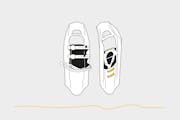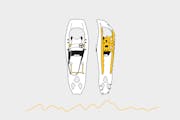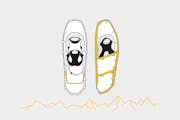Buying snowshoes – everything you need to know
Which snowshoes work best for different types of tours? And which shoes do you wear with snowshoes? Here’s detailed information on snowshoes and what to look out for when buying them.
Material
Snowshoes are made of either plastic or aluminium. Models made of plastic are more flexible and therefore roll better when walking compared to those made of aluminium. Snowshoes made of aluminium are very durable and particularly suitable for extreme conditions.
The traction rails, integrated crampons or spikes give you grip on snow and ice. These are usually made of metal and are particularly robust. They’re ridged and sharp, so make sure you don’t damage your other equipment when packing. The easiest way to avoid this is by using specially designed bag.
SizeSize
The snowshoes size you need depends primarily on your planned tours – that is, the environment you’ll use them in – as well as your body weight and pack weight. As a guide, normal-weight people around 1.70 m tall carrying a daypack need snowshoes with a length of about 56 centimetres, while taller people need about 64 centimetres. Let us advise you – we’ll find the right snowshoes for you!
However, with smaller snowshoes, the climbing aid is closer to the binding because they are designed for smaller feet. The climbing aid is a fold-out piece of metal that makes it easier for you to go uphill. Regardless of whether you have large or small feet, make sure when trying them on that the climbing aid is in the middle of your heels.
Smaller snowshoes are best suited for alpine terrain, as they have a smaller footprint and allow you to move faster. On the other hand, they offer little lift in deep powder snow. This can be a disadvantage, especially for heavier people or if you’re carrying a lot of weight.
Narrow snow shoes make walking more comfortable because you only have to slightly adjust your stride width. This is feels better, especially on longer tours. However, narrow models also have less buoyancy on the snow.
Hire snowshoes
At Transa you can both purchase and hire snowshoes. This is ideal if you want to try out snowshoeing.
Various models
Different models are better for different terrain. It’s best to buy snowshoes for the conditions that you’re most likely to see often.

Easy tours
Maintained and signposted trails through snow-covered landscapes, with few steep sections: if that describes your favourite snowshoe routes, then simple, light models will suffice. On such tours, the snowshoes don’t have to be particularly grippy and don’t need large spikes. Quite the opposite, actually – they rob you of extra energy on groomed trails because you have to pull them out of the snow with every step. These types of snowshoes therefore have only short spikes and don’t always have crampons.

Steeper terrain
When buying snowshoes for pre-alpine terrain, look out for traction rails on the outside and inside. These jagged edges provide good grip. Integrated crampons are also important. They dig into the snow with every step. The snowshoes should also have a climbing aid. Usually, this is a small metal arch under the heel that you can raise for steep passages, which makes walking uphill much more comfortable.

Steep, technical tours
You plan routes on steep, rough terrain, so the snowshoes need to give you particularly good grip. This is ensured by traction rails on all sides, including the front and rear. Integrated crampons are also essential. A climbing aid and suitable binding are just as important. Snowshoes in this category tend to be slightly heavier than those for flat terrain. But the extra weight is necessary to give you a secure grip in Alpine environments.
Binding systems
Just as the shape of snowshoes varies depending on the terrain, so does the binding. If you’re mainly walking on flat surfaces, a belt tie is sufficient: you buckle it around your shoe like a belt. But once you’re out and about in pre-Alpine or Alpine terrain, a more secure binding is important. There are different models available; below is an overview of the most common:
Paragon binding: you stretch a plastic net over your shoe, which you can attach to four contact points to secure it firmly in place. Many MSR snowshoes have this kind of binding.
BOA closure system: this system can also be found in snowboard boots or light hiking boots. Instead of lacing, the wires or laces are tightened by turning a knob. This tried-and-tested system is very common. The binding system is often found in Tubbs snowshoes.
Regardless of the binding, if you’re looking to buy snowshoes, check whether you can close and open the binding while wearing thin gloves.
Shoes for snowshoeing
When snowshoeing, you need sturdy shoes with a tall shaft. It’s important that they’re waterproof, lined and comfortable. They should also offer support. Winter boots are usually good because they provide additional insulation. In milder temperatures, hiking boots with thick socks are also a good choice. Make sure that the snowshoe binding does not press the metal hooks for the laces against your foot.
When buying snowshoes, be sure to take the shoes you want to wear for snowshoeing with you. This way, you can make sure that the snowshoe binding is wide enough so that nothing slips or rubs against your shoes.
Important accessories
Taking proper care of your snowshoes
To make sure your snowshoes last as long as possible, it’s worth maintaining them regularly. This includes:
Cleaning: remove snow and dirt from your snowshoes after each tour. This is best done with a soft brush and warm water; soap is unnecessary.
Leave to dry: let the snowshoes dry before you put them away. However, do not place them next to the stove or directly in the sun, as this can damage the material.
Inspect: check the binding and screws regularly. Tighten loose screws and nuts and replace damaged parts.
Storage: store your snowshoes in a dry, cool place. You can hang them up or lay them down. Make sure the spikes won’t damage anything.
Avalanche safety
As with ski touring, you also have to keep avalanche risks in mind while snowshoeing. Groomed and signposted winter hiking trails are usually safe, and ski resort websites often have up-to-date information if a trail or part of it is blocked due to avalanche risks.
If you’ve gone off the beaten track in Alpine terrain, be sure to pack avalanche gear: an avalanche transceiver (AVS), shovel and probe. But just having them isn’t protection enough – learn and practice using safety equipment in advance, ideally in a course.
Do you have any questions?
Get personal advice from our sales advisors in the shops or online and over the phone from customer service. We'll be happy to help you.
- Free shipping from CHF 99
(With the TransaCard always free of charge)
- Secure payment with Twint, Visa and more
- 14 days cancellation right





































